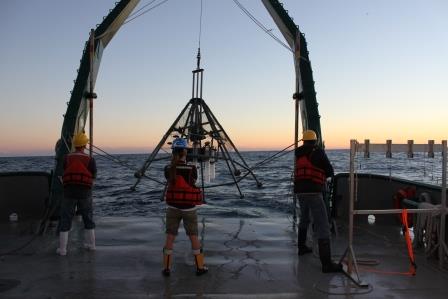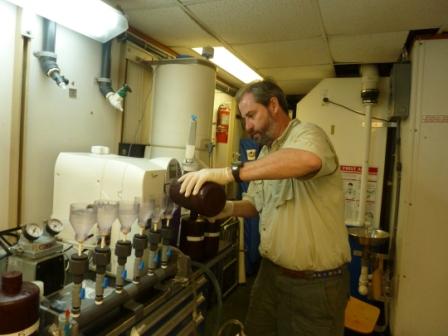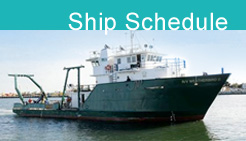Deep Sea Fish and Sediment Surveys in the Gulf
Day 2 of Teacher Matt’s journey at sea

Multicore launch to collect deepsea sediment samples. Scientists Brian Wells, Leslie Wade and Lee Russell
February 6, 2013
After getting a good night’s rest we were greeted by the smell of a hot breakfast of blueberry pancakes, hash browns, sausage, bacon; and of course, fresh fruit. There seems to always be fresh fruit and vegetables at every meal. It wasn’t long after breakfast that we approached the next sampling location.
This location resulted in good core samples. It seemed deep to me being 505 meters down; but it was actually relatively shallow for the Gulf which is over 3000 meters in several locations. One thing that we all know is that the oceans are very cold on the bottom. It was very evident in the tubes as there was condensation on the outside.
Now it’s a waiting game until we get to the next site.
I just received my training on how to do the water filtration for the CHN analysis.
That’s Carbon, Hydrogen, and Nitrogen. The Nisken bottles were brought to the surface and everyone jumped into action; each person taking their water samples for their own individual purposes. My samples were last to be drawn as I waited in the “long lab” with the water filtration system ready to go.
While I was busy filtering, just focusing on my little piece of the puzzle, chief scientist, Leslie and Matt, who is a student from Eckerd College, deployed the bongo net. This is two gigantic plankton nets pulled side by side, and as the name implies, the ring around the front resembles bongos.

C-IMAGE Chief Scientist, Leslie Wade and Eckerd College student, Matt Russell retrieving the Bongo Nets during nightime sampling of plankton community.
It is 10:30PM now and I am waiting for the second sample series to arrive from this site. Because the water depth was 1200 m we needed to do two casts of the Niskin bottles to collect enough water at each depth. The rosette is set up to hold 12 Niskin bottles.
| Print article | This entry was posted by greely on February 8, 2013 at 1:20 am, and is filed under Oceanic Updates. Follow any responses to this post through RSS 2.0. You can leave a response or trackback from your own site. |




about 10 years ago
Hello there Nice post. Very much appreciated!